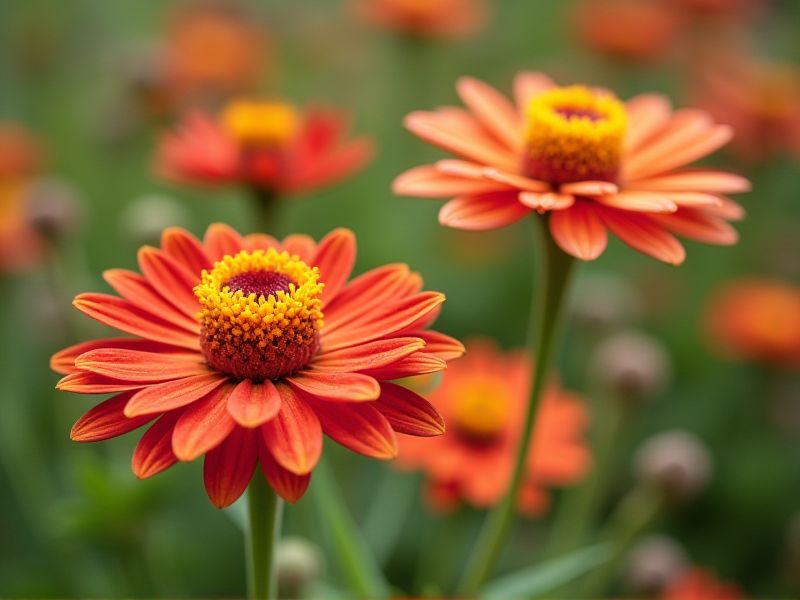
Drought-tolerant plants that bloom provide vibrant colors and resilience to arid environments. Species such as the California poppy and lavender thrive with minimal water, yet display stunning flowers that attract pollinators. Agave and succulents, like Echeveria, not only store water efficiently but also offer unique shapes and colors, enhancing your garden's visual appeal. Native plants, including coneflowers and black-eyed Susans, are excellent choices as they adapt well to local climates and support biodiversity. Incorporating these drought-resistant varieties into your landscaping can create a beautiful, low-maintenance garden that flourishes even in dry conditions.
List of some Drought-tolerant plants that bloom
- Lavender (Lavandula)
- Red Yucca (Hesperaloe parviflora)
- Coneflower (Echinacea)
- Blanket Flower (Gaillardia)
- Black-eyed Susan (Rudbeckia hirta)
- Russian Sage (Perovskia atriplicifolia)
- Sedum (Sedum spp.)
- Lantana (Lantana camara)
- California Poppy (Eschscholzia californica)
- Agastache (Agastache spp.)
Important things about Drought-tolerant plants that bloom
Water-Efficient Care
Drought-tolerant plants that bloom not only conserve water but also enhance your garden's beauty. Varieties such as lavender, salvia, and agastache thrive in low-water conditions, offering vibrant colors and delightful fragrances. These resilient plants are perfect for creating a sustainable landscape, as they require minimal irrigation once established. By incorporating these species into your garden, you can promote biodiversity while significantly reducing water usage.
Native Species Availability
Drought-tolerant plants that bloom are essential for creating vibrant landscapes while conserving water resources. Native species such as California poppy, desert marigold, and blackfoot daisy thrive in arid conditions, providing colorful blooms during dry seasons. These resilient plants not only enhance your garden's aesthetic but also support local wildlife by attracting pollinators like bees and butterflies. By incorporating these native drought-tolerant varieties, you can help promote biodiversity while effectively managing water usage in your landscape design.
Soil Adaptability
Drought-tolerant plants, such as lavender, succulents, and agave, thrive in various soil types, making them ideal for regions experiencing water scarcity. These plants possess unique adaptations, enabling them to store water and utilize it efficiently, which allows them to bloom beautifully even under dry conditions. Incorporating drought-tolerant species into your garden not only enhances its aesthetic appeal but also promotes sustainable gardening practices, reducing water usage. Understanding the specific soil requirements of these plants can help you create a resilient landscape that flourishes despite challenging conditions.
Seasonal Blooming Patterns
Drought-tolerant plants such as succulents, lavender, and agave are renowned for their remarkable ability to thrive in arid conditions while still producing vibrant blooms. These plants often exhibit seasonal blooming patterns, with many flowering during warm, dry months to attract pollinators when other resources are scarce. For instance, the California poppy showcases bright orange blooms in late spring, while desert sage can burst into vivid purple flowers during the summer, enhancing local biodiversity. By incorporating these resilient beauties into your landscape, you can create a stunning and sustainable garden that flourishes despite water scarcity.
Attracts Pollinators
Drought-tolerant plants, such as lavender, sedum, and echinacea, play a vital role in attracting pollinators like bees, butterflies, and hummingbirds. These resilient flora not only withstand dry conditions but also produce vibrant blooms that provide essential nectar and pollen throughout the growing season. Incorporating these plants into your garden enhances its ecological value while ensuring a sustainable habitat for local pollinators. Choosing native drought-resistant species further supports biodiversity, contributing to the health of your local ecosystem.
Pest Resistance
Drought-tolerant plants that bloom not only add aesthetic appeal to your garden but also exhibit remarkable pest resistance, making them ideal choices for sustainable landscaping. Varieties such as Lavandula (lavender) and Echinacea (purple coneflower) thrive in arid conditions while repelling common garden pests due to their aromatic oils and tough foliage. These resilient plants require less water and maintenance, enabling you to conserve resources while enjoying vibrant blooms year-round. Incorporating drought-resistant flowering plants into your landscape can enhance biodiversity, attract beneficial pollinators, and reduce reliance on chemical pest control methods.
Low Maintenance Requirements
Drought-tolerant plants that bloom are ideal for gardens in arid climates, as they require minimal water after establishment. Varieties like Echinacea, lavender, and desert marigold not only add vibrant color but also attract pollinators, enhancing biodiversity in your garden. These resilient plants are adapted to survive with infrequent watering, making them perfect for sustainable landscaping. Opting for blooms from these species can lead to a visually appealing landscape that conserves water while showcasing nature's beauty.
Variety Of Colors And Shapes
Drought-tolerant plants offer a stunning array of colors and shapes that enhance any garden while requiring minimal water. Species such as the vibrant red Salvia, delicate blue Agastache, and striking yellow Euphorbia provide visual interest and attract pollinators. Succulents, with their unique forms, range from the rosette shape of Echeveria to the tall spikes of Agave, enriching your landscape design. By incorporating these resilient plants, you not only conserve water but also create a dynamic and colorful outdoor space.
Landscape Versatility
Drought-tolerant plants that bloom add vibrant color and texture to landscapes while conserving water resources. Varieties such as Agastache, Echinacea, and Sedum thrive in arid conditions, showcasing stunning flowers that attract pollinators like bees and butterflies. Native plants, such as California poppy and lavender, require minimal maintenance, making them ideal for sustainable gardening practices. By selecting these resilient species, you can create an eye-catching garden that flourishes even in dry climates.
Climate Resilience
Drought-tolerant plants are essential for sustainable landscaping, especially in arid regions where water scarcity is a significant concern. These resilient flora, such as lavender, succulents, and native wildflowers, not only conserve water but also bring vibrant colors and aromas to your garden. By selecting plants like agave or yucca, you can create a beautiful, low-maintenance landscape that thrives even in dry conditions. Incorporating these drought-resistant species enhances biodiversity and supports local pollinators, crucial for maintaining ecological balance.
